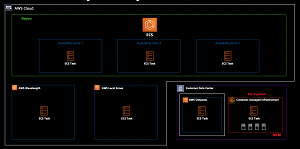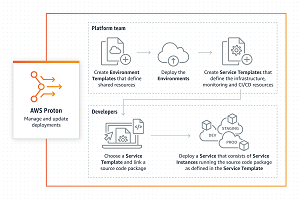News
AWS Advances Containers on Four Fronts
Amazon Web Services (AWS) announced four new advances for containers on its cloud computing platform during this week's re:Invent conference.
The cloud giant is expanding the reach of its container and Kubernetes services to on-premises installations while also automating container and serverless application development/ deployment and making it easier for developers to share and discover public software images.
"Containers provide a standard way for developers to package and run applications quickly and reliably in any environment, while also improving resource utilization and reducing cost," AWS said in a news release. "AWS is now making it even easier to provision, deploy, and manage container applications."
The four major initiatives announced at re:Invent include:
- Amazon Elastic Container Service (Amazon ECS) Anywhere: This allows users to leverage Amazon ECS to orchestrate containers in their own datacenters.
 [Click on image for larger view.] ECS Anywhere (source: AWS).
[Click on image for larger view.] ECS Anywhere (source: AWS).
Coming in the first half of next year, this is an extension of the existing Amazon ECS Anywhere offering for running container projects in a secure, reliable and scalable way in the cloud. By running ECS Anywhere, AWS said organizations aren't required to run, update or maintain their own container orchestrators on-premises any more.
Consistent tooling and APIs for all container-based applications is provided, allowing for similar Amazon ECS experiences for cluster management, workload scheduling, and monitoring whether in the cloud or in on-premises datacenters.
"ECS Anywhere will allow customers to deploy native Amazon ECS tasks in any environment," AWS said. "This will include the traditional AWS managed infrastructure, as well as customer-managed infrastructure. All this without compromising on the value of leveraging a fully AWS managed, easy to use, control plane that's running in the cloud, and always up to date."
- Amazon Elastic Kubernetes Service (Amazon EKS) Anywhere: Taking the same "anywhere" approach as Amazon ECS Anywhere, this lets users run Amazon EKS in their own on-premises datacenters -- on any infrastructure -- and works with Amazon EKS Distro, a distribution of the same open source Kubernetes and dependencies deployed by Amazon EKS for users to create Kubernetes clusters.
 [Click on image for larger view.] EKS Anywhere (source: AWS).
[Click on image for larger view.] EKS Anywhere (source: AWS).
It's also coming next year, said to serve use cases including:
- Train models in the cloud and run inference on-premises
- Workload migration (on-premises to cloud)
- Application modernization
- Data sovereignty
- Bursting
- AWS Proton: This gives developers a new service for automating container and serverless application development and deployment.
It provides a new approach to deal with demands, requirements and special considerations needed for container/serverless projects where -- in contrast to traditional projects that feature a single block of code -- applications are assembled from disparate chunks of code that may come from different teams, may require their own infrastructure and may be updated and developed on different schedules.
 [Click on image for larger view.] AWS Proton (source: AWS).
[Click on image for larger view.] AWS Proton (source: AWS).
"As customers have naturally gravitated to container and serverless application development, they've also found that trying to coordinate all of the changes across their infrastructure provisioning, code deployments, and monitoring tools can be a challenge," AWS said. "Customers lack an integrated solution that ties together all the tasks, including resource provisioning, code deployments, and monitoring. Central infrastructure teams try to provide guidance to the developers, and some even have built their own custom tools to help developers implement best practices, but the intricacies of container and serverless application development and deployment remain a challenge that slows down application development at many organizations."
That's where AWS Proton comes to the rescue, the company said.
Use cases include:
- Streamlined management
- Managed developer self-service
- Infrastructure as code adoption
- Amazon Elastic Container Registry (Amazon ECR) Public: AWS describes this as an easy and highly available way to share and deploy container software publicly.
The idea is to make it easier for developers to work with -- and share and find -- container images that provide packages including common software such as an OS, database, app components and so on.
It improves upon the current scheme that developers must use when they want to publicly publish popular software -- language libraries, web servers, databases and more -- as images. Developers can't just download them from Amazon ECR to publish them, rather they are required to first download the images from public web sites and registries, such as Docker Hub. This can add complexity and cause various problems.
 [Click on image for larger view.] Amazon ECR (source: AWS).
[Click on image for larger view.] Amazon ECR (source: AWS).
"To solve this challenge, Amazon ECR has now added a public registry for developers to store, manage, share, and deploy container images for anyone to discover and download," AWS said. "Customers can use Amazon ECR Public to host both their private and public container images, eliminating the need to use public web sites and registries. Customers no longer need to operate their own container repositories or worry about scaling the underlying infrastructure and can quickly publish public container images with a single command."
The Amazon ECR Public Gallery currently shows 782 repositories for different OSes and architectures, ranging from Amazon Linux to WordPress.
This year's AWS re:Invent conference is spread out over three weeks. For more news on this year's event, see these articles published on our sister site, AWS Insider:
About the Author
David Ramel is an editor and writer at Converge 360.